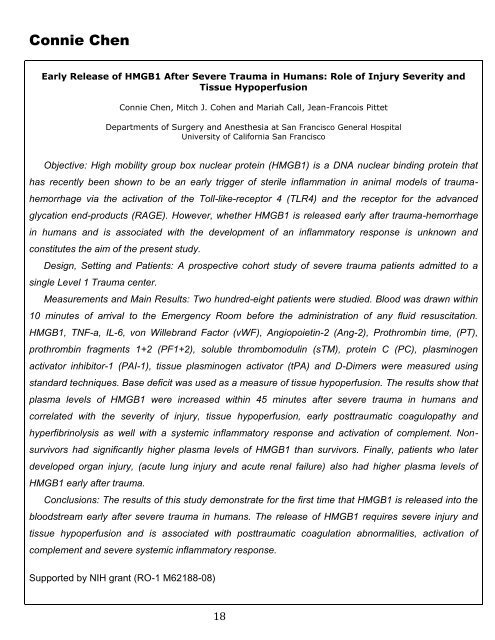student research day - Case Western Reserve University School of ...
student research day - Case Western Reserve University School of ...
student research day - Case Western Reserve University School of ...
Create successful ePaper yourself
Turn your PDF publications into a flip-book with our unique Google optimized e-Paper software.
Connie Chen<br />
Early Release <strong>of</strong> HMGB1 After Severe Trauma in Humans: Role <strong>of</strong> Injury Severity and<br />
Tissue Hypoperfusion<br />
Connie Chen, Mitch J. Cohen and Mariah Call, Jean-Francois Pittet<br />
Departments <strong>of</strong> Surgery and Anesthesia at San Francisco General Hospital<br />
<strong>University</strong> <strong>of</strong> California San Francisco<br />
Objective: High mobility group box nuclear protein (HMGB1) is a DNA nuclear binding protein that<br />
has recently been shown to be an early trigger <strong>of</strong> sterile inflammation in animal models <strong>of</strong> trauma-<br />
hemorrhage via the activation <strong>of</strong> the Toll-like-receptor 4 (TLR4) and the receptor for the advanced<br />
glycation end-products (RAGE). However, whether HMGB1 is released early after trauma-hemorrhage<br />
in humans and is associated with the development <strong>of</strong> an inflammatory response is unknown and<br />
constitutes the aim <strong>of</strong> the present study.<br />
Design, Setting and Patients: A prospective cohort study <strong>of</strong> severe trauma patients admitted to a<br />
single Level 1 Trauma center.<br />
Measurements and Main Results: Two hundred-eight patients were studied. Blood was drawn within<br />
10 minutes <strong>of</strong> arrival to the Emergency Room before the administration <strong>of</strong> any fluid resuscitation.<br />
HMGB1, TNF-a, IL-6, von Willebrand Factor (vWF), Angiopoietin-2 (Ang-2), Prothrombin time, (PT),<br />
prothrombin fragments 1+2 (PF1+2), soluble thrombomodulin (sTM), protein C (PC), plasminogen<br />
activator inhibitor-1 (PAI-1), tissue plasminogen activator (tPA) and D-Dimers were measured using<br />
standard techniques. Base deficit was used as a measure <strong>of</strong> tissue hypoperfusion. The results show that<br />
plasma levels <strong>of</strong> HMGB1 were increased within 45 minutes after severe trauma in humans and<br />
correlated with the severity <strong>of</strong> injury, tissue hypoperfusion, early posttraumatic coagulopathy and<br />
hyperfibrinolysis as well with a systemic inflammatory response and activation <strong>of</strong> complement. Non-<br />
survivors had significantly higher plasma levels <strong>of</strong> HMGB1 than survivors. Finally, patients who later<br />
developed organ injury, (acute lung injury and acute renal failure) also had higher plasma levels <strong>of</strong><br />
HMGB1 early after trauma.<br />
Conclusions: The results <strong>of</strong> this study demonstrate for the first time that HMGB1 is released into the<br />
bloodstream early after severe trauma in humans. The release <strong>of</strong> HMGB1 requires severe injury and<br />
tissue hypoperfusion and is associated with posttraumatic coagulation abnormalities, activation <strong>of</strong><br />
complement and severe systemic inflammatory response.<br />
Supported by NIH grant (RO-1 M62188-08)<br />
18
















